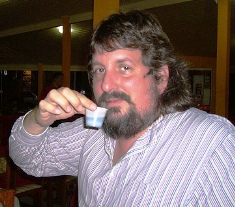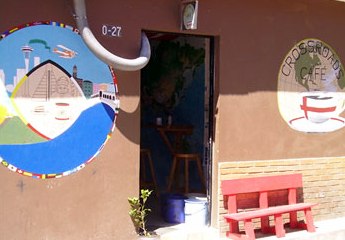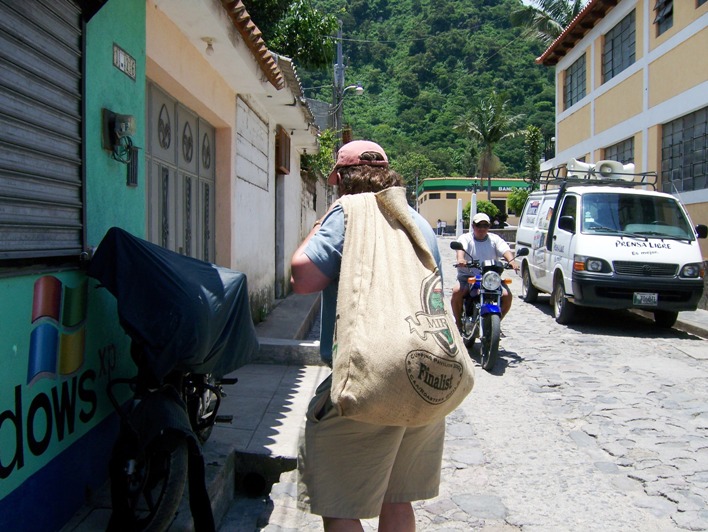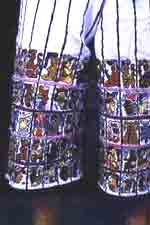| Coffee in Guatemala James Hayes-Bohanan , Ph.D. Coffee Maven and Geographer Bridgewater State College UPDATED November 12, 2008 We spent the summer 2008 family vacation exploring coffeelands around Lake Atitlan, allowing me to see coffee other than Nicaraguan for the first time. See photos of this trip on Flickr in the Guatemala 08 set (updated August 15), which is part of my coffee photo collection. |
 |
|
I have
expanded this site's information about coffee shops, coffee roasters,
coffee tours, health effects,
and coffee preparation, and have moved that information to other pages. Please explore! |
|
Upon landing in Guatemala City, we made our way quickly to Antigua, a charming old city that is a favorite of students and tourists from the region and from far away. We stayed in a small, garden-style hotel of the kind we have enjoyed elsewhere in Latin America. From there, we could walk and walk to markets, shops, plazas, museums -- all the while enjoying the views of volcanoes just outside the city and interactions with friendly Antigüenses. I have never been in a place with as many travel agencies as the center of Antigua -- several could be found on each block, offering everything from day trips to international excursions throughout Central America. Among all of these choices, Pam noticed a coffee tour. Since we were planning to visit coffee-growing communities in Atitlan, I at first dismissed the idea of spending part of our brief time in Antigua on a "standard" tour. Deciding that an overview would be good for our daughter (who had never been on a coffee farm before), we signed up for the tour of Finca Filadelfia, a conventional coffee estate with something like a million trees. As it turns out, I learned many new things, particularly about the grafting of Arabica and robusta plants, and enjoyed the visit, our guide Josue, and the company of a fellow tourist from Spain. Josue challenged us to find ripe beans -- completely out of season -- and we did manage to find a bean or two each. |
Atitlan -- At the water Nobody is quite certain when a tremendous volcano collapsed to create the caldera that holds Lake Atitlan (named at the water by the Mayans), but it seems to have been well before human settlement. A number of newer (geologically speaking) volcanoes intrude on this 11-mile-wide wonder, stretching up from the nearly mile-high surface, touching the sky and creating an ideal home for exquisite coffee. The lake is surrounded by small cities and villages that provide a rich tapestry of indigenous and post-colonial culture.  We were invited to the area to learn about the coffee,
the communities that produce it, and efforts to sustain and develop
these communities. One of our first stops was the indispensible Crossroads
Cafe in Panajachel. One of the key things that is missing in
conventional coffee is a connection between producer and consumer. The
Crossroads Cafe is very unusual in the way that it closes the loop,
connecting growers and consumers through the development of expertise
in roasting and brewing in the
growing region. The cafe is aptly named, as this unique model
attracts people from just up the mountain and from the other side of
the world. We were invited to the area to learn about the coffee,
the communities that produce it, and efforts to sustain and develop
these communities. One of our first stops was the indispensible Crossroads
Cafe in Panajachel. One of the key things that is missing in
conventional coffee is a connection between producer and consumer. The
Crossroads Cafe is very unusual in the way that it closes the loop,
connecting growers and consumers through the development of expertise
in roasting and brewing in the
growing region. The cafe is aptly named, as this unique model
attracts people from just up the mountain and from the other side of
the world.The cafe is featured in the discussion of coffee in Richard Morgan Szybist's excellent little volume, The Lake Atitlan Reference Guide: The Definitive Eco-Cultural Guidebook on Lake Atitlan. It was only after reading a couple chapters that I realized I had gone to school with this author -- we studied together in the Latin American Area Studies program at the University of Arizona in the early 1990s. A few years after that, he moved to Panajachel, where he has since become a resident expert on the cultures of the lake region. |
 I thank Pam for this fun photograph, which we call Coffee Claus. Whenever I travel to coffeelands, I bring back gifts of coffee. My new friend Mike was kind enough to give me a beautiful bag in which to carry it all! Because coffee begins to stale immediately upon roasting, I keep only a couple of pounds for the family, distributing the rest to friends who we know will appreciate the coffee and the farmers who make it possible. Pam's photo captures a very nice street scene as well -- in the upper part of Panajachel where normal life takes place (as opposed to the frantic street-market seen a couple blocks away, where we were staying). The ubiquitous ...dows in the corner adds a nice reminder of the globalization process we see unfolding in so many interesting ways. |
Thank
the farmers!
| On our third day in the Atitlan
region, we had two brief meetings with coffee farmers in the municipio
of San Antonio. The first visit was to the village of
San Coral, high above the eastern shores of Lake Atitlan. The village
is on the rim of the caldera at an
elevation of close to 6,00 feet, an excellent location for both coffee
and avocados. This was my very first
opportunity to meet with farmers who are operating completely in the
conventional system, and to hear first-hand of the difficulty of
working without an organization. When the farmers of San Coral sell
their coffee at the end of each day of the harvest, they
are at the mercy of buyers -- coyotes
-- who come directly to their farms. The San Coral visit was humbling in several ways. Although we made it clear that I am just an academic observer, the communty leaders greeted me not only with warmth and hospitality, but also with tremendous gratitude. They were happy to have anyone listen to them. One of the problems we discussed most was the lack of water in the community, so we were deeply moved when one of the leaders left briefly and returned with bottled water for all of us. Ordinarily, I oppose bottled water -- especially in developing countries -- but we could not refuse this very meaningful gesture. We left the meeting with the intention of helping these farmers to begin to make connections to more equitable trading systems. I hope we are successful! Our meeting with Alfanso (right) in nearby Chitulul -- also in San Antonio -- was a bit of a reality check. "If only they can get organized!" was the hopeful sentiment we all shared as we left the first meeting. Alfonso and the farmers in his community are organized at a local level, but still are unable consistently to sell their coffee at a fair price. Clearly, a lot remains to be done! |
|
 |
The city of Santiago Atitlan, the
capital of the Tzutujil Maya nation, is located directly across the
lake from our base in Panajachel. Each community around the lake has
distinctive traje (embroidered clothing). In most
cases, it is the traje of women that is distinctive, but the
men of Santiago are known for their scaf -- long white shorts with purple
stripes, often richly embroidered. If you sport me wearing anything
like the gear shown at left, you will know where I got them! The image is from the official Santiago web site, where you can read about Santiago's weaving heritage. The Woven Voices web site at Florida State University describes the traje of all the lake communities. It also describes the bitter history of US-sponsored violence in the region. Reserva Natural Atitlán is a terrific example of agroecotourism, lakeside on the outskirts of Panajachel. Coffee is grown on a nature reserve that includes adventure (though friends warned us that the zip line is not the safest kind), waterfalls, monkeys, rare coatis, and butterflies. Amid all of the lush vegetation and diverse animal life grows organic coffee! |
View Larger Map
Dr. James Hayes-Bohanan